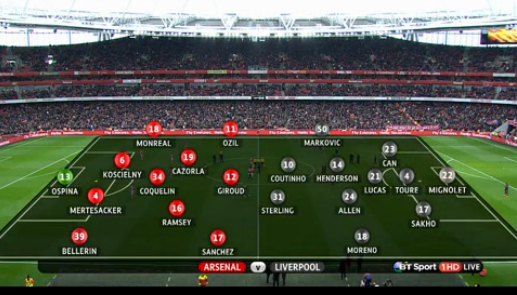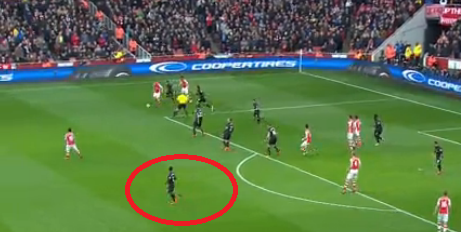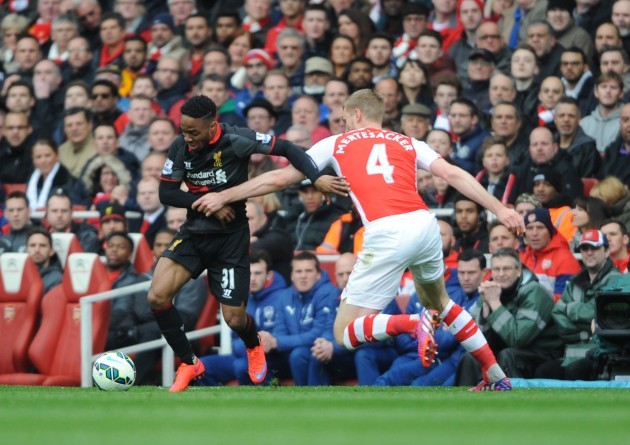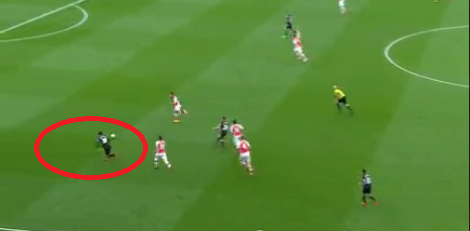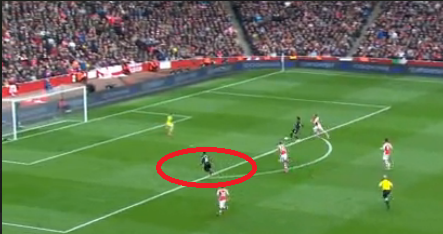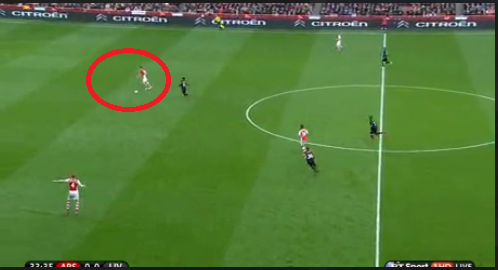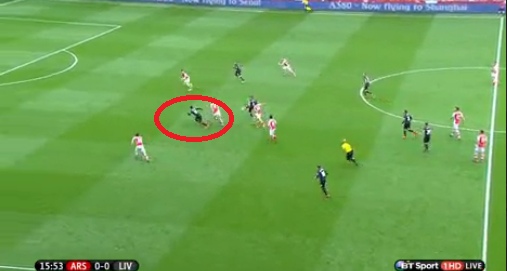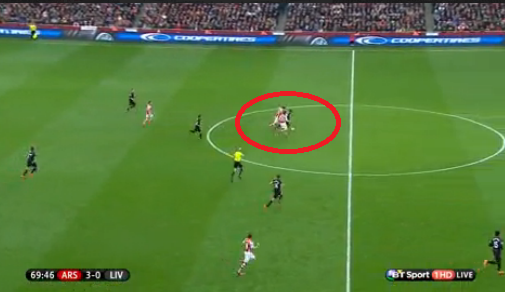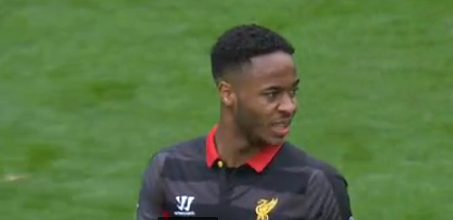1. Talent
THE MOST OBVIOUS and perhaps also the most contentious reason.
Exactly how good a player Sterling is has become a topic of intensive debate in recent weeks.
The Liverpool youngster currently has less goals than Jonathan Walters — a fact that’s been pointed out and subsequently made light of by the Ireland international.
Nonetheless, Sterling was a big part of the Reds’ title push last season, managing nine goals in 33 appearances, however during this campaign, he has by most accounts failed to match the impressive form of last year.
That said, his form is hardly unimpressive either. In addition to his six goals in 29 games, he also has seven assists — two more than in all of last season — a stat bettered only by seven other players in the Premier League this season. As of last week, he was also 14th in terms of chances created, 19th when it comes to shots on target and ninth in the successful dribbles list.
And perhaps more pertinently, Brendan Rodgers’ decision to change to a 3-4-3 system, using Sterling as the primary attacker, is routinely cited as a big reason for Liverpool’s significant post-Christmas improvement.
He is often compared to other speedy Premier League wingers such as Aaron Lennon and Shaun Wright Philips, who most people now agree have failed to deliver on their obvious potential. Lennon became the youngest player to appear in the Premier League with Leeds at the age of 16 years and 129 days (almost exactly a year younger than Sterling was when he made his debut with Liverpool) in 2001 and impressive initial form after signing with Tottenham saw him linked with a big-money move to Chelsea.
Wright-Philips, by contrast, actually made a £21million move to Chelsea in 2005, after a series of impressive displays at Man City, however he never really established himself as a first-team regular. Now at QPR, the 33-year-old has made just three Premier League appearances all season.
But the big difference between Sterling and those aforementioned players is the growing sense that the Liverpool player has a bit more depth to his game than the average stereotypical winger. Rather than just being a speed machine, he has the ability to pick out sublime passes as well (see below)
https://vine.co/v/MmgOqw5Ad0t
2. Adaptability
Sterling had by no means his best game at the weekend against Arsenal, nonetheless there were glimpses of skill suggesting why he is so highly rated.
One reason for the ex-QPR youth player’s excess value is his adaptability.
(Sterling began Saturday’s game as Liverpool’s primary attacker)
In the Arsenal match and throughout the season, Sterling has shown that he can play on both wings, as well as in the main central attacking position. He can also operate behind the striker and as a wing-back if necessary.
(Sterling looked isolated at times in the lone frontman role)
In the first half against Arsenal, he appeared somewhat isolated at times and was well marshalled by German World Cup-winning defender Per Mertesacker, despite some critics suggesting the youngster’s pace could prove too much for the 30-year-old centre-back.
(Sterling struggles to get away from Mertesacker)
And on the rare occasions where opportunities arose, Sterling struggled to make an impact, often over-hitting crosses, misplacing passes and straying offside.
(Sterling is caught offside by a well-drilled Arsenal defence)
He should have put Liverpool 1-0 up and surely would have, if teammate Lazar Markovic had executed a relatively straightforward pass in his direction accurately.
(Markovic fails to find Sterling with a pass)
While the game wasn’t going his way, Sterling continued to show good discipline, pressing opponents and holding his position in the centre for the benefit of the system, which is another reason why he’s so highly valued — Sterling is invariably a team player and has a conspicuous element of selflessness in his play that, sometimes, even top players lack.
(Sterling puts the Arsenal defence under pressure)
Moreover, even an off-form Sterling is more of a threat than many other players. He hit a shot narrowly wide in the 24th minute on Saturday and was sporadically linking up well with teammates.
However, it wasn’t until the second half and he was moved to the wing to allow substitute Daniel Sturridge go up front that he made a positive impact on the scoresheet.
Sterling drew the foul for the penalty that led to Liverpool’s only goal of the game and generally gave opposition full-back Hector Bellerin a torrid time.
In fact, Bellerini was somewhat lucky not be sent off, having already been booked for a cynical drag back that prevented Sterling from exposing him on the counter-attack.
However, these were rare enough bright spots in what was a miserable day overall for Liverpool and Sterling, as the youngster frequently overhit crosses and conceded possession in promising positions — perhaps committing these uncharacteristic errors on account of the considerable pressure the player was under going into the game for the ill-advised decision to publicly express his ostensible dissatisfaction with the club – a move that Liverpool legend, Jamie Carragher, among others, labelled a “disgrace”.
3. The home-grown rule
On the face of it, a player’s background should be irrelevant when it comes to his valuation, but in the Premier League, it is not quite so simple.
Its significance in relation to Sterling goes back to the start of the 2010/11 season, when the home-grown player rule first took effect.
The rule decreed that all 20 clubs must have at least eight home grown players in their 25-man squad.
The Premier League rules define a home-grown player as “one who, irrespective of his nationality or age, has been registered with any club affiliated to the Football Association or the Football Association of Wales for a period, continuous or not, of three entire seasons or 36 months prior to his 21st birthday (or the end of the season during which he turns 21).”
With the number of top-quality home-grown players patently limited as it is, Sterling — as one of England’s few exceptional home-grown players — becomes even more invaluable. Man City, for example, will lose Frank Lampard in the summer, while James Milner is rumoured to be on the verge of departing as well, so they will be one of many big clubs looking to boost their home-grown quota in the summer.
4. The market
Many people have balked at the idea of Raheem Sterling being worth approximately £50million (€68.5million), as well as being unimpressed with his apparent refusal to accept Liverpool’s offer of a new, lucrative £100,000-a-week contract.
But anyone who’s been paying attention to the manner in which the British transfer market has been operating in recent times will not be so surprised. The £100,000 offered is only half what another player of considerable promise (albeit undoubtedly greater standing), Eden Hazard, earns. Meanwhile, Juan Mata, at 26, reportedly gets £150,000 a week.
One other important factor is the upcoming new Premier League TV deal that is understood to be worth £5billion over a three-year period.
Players’ wages will naturally become more exorbitant than ever on the back of this big-money deal, which is one of the reasons why Sterling feels entitled to be paid considerably higher wages compared to his current deal, which is reported to be approximately £35,000 a week.
There is no doubting that the player has improved substantially since he signed his previous contract as an 18-year-old in 2012. While a promising footballer at the time, he had made just 25 appearances at senior level for Liverpool. Since then, he has established himself as a regular at both club and international level, ultimately earning a nomination as one of the six players on the shortlist for the PFA Young Player of the Year award last season.
A study by the International Centre for Sports Studies (CIES) Football Observatory back in January even ranked Sterling as the seventh most valuable player in the world, just below Sergio Aguero and one place above Cesc Fabregas.
Keep in mind also that some of the deals that have been done of late in the transfer market — Shane Long, a striker who invariably struggles to score goals, was bought by Southampton for £12million. Mario Balotelli, the notoriously erratic Italian international, was considered a bargain at the time when Liverpool paid £16million for him back in August. Gareth Bale, perhaps most notoriously, is understood to have cost Real Madrid roughly £100million to buy from Tottenham.
It’s an insane market, but based on such crazy rules, it seems understandable that Sterling is likely to cost any club upwards of £50million should they elect to buy him in the summer, and that figure would be higher were it not for the fact that his contract expires soon enough (June 2017). And of course, as that date approaches, Sterling’s valuation will inevitably continue to dwindle rapidly — a potential motivation for the Fenway Sports Group that owns Liverpool would be to sell him at the end of the season rather than risk losing the player on a free transfer in two years’ time.
5. Age + experience
While Sterling may, to most people’s eyes, be currently inferior to some of the players he finishes ahead of in the aforementioned CIES study, his overall higher valuation comes down to a number of factors, with potential perhaps being his most significant attribute.
There are few if any footballers in the game currently within Sterling’s age group that can boast the level of experience that he possesses.
At 20, Sterling has already played in the World Cup and Champions League, and he has swiftly developed into a key player for both Liverpool and England.
Furthermore, he hardly ever seems daunted by these big games. During their World Cup group match with Italy, Sterling was generally regarded as England’s best player, and laid on an immaculate, defence-splitting pass in the build-up to their only goal of the game.
https://vine.co/v/MIApOJPqVFe
However, for all he has achieved at this point in his career, the jury is still out to an extent on Sterling.
There are elements of his game that could be improved, with finishing being one of his most notable weak spots. This flaw was particularly evident in the 3-0 loss against Man United back in December. The final score failed to fully reflect how the match panned out however, as Liverpool spurned a number of good chances, with Sterling — who was playing in the main striker role that day — a guiltier culprit than most.
In addition, to become known as a genuinely great player, he will need to start winning trophies sooner rather than later — something he is less likely to achieve at Liverpool than, say, Real Madrid.
Of course, it’s easy to deride Sterling as a mercenary or a money grabber, as many more or less have, and he could undoubtedly earn better wages elsewhere if that is his primary intention.
But perhaps, as some of the less cynically-minded pundits have suggested, Sterling is being truthful when he insists it’s “not about the money”. Perhaps he really does seek to better himself as a footballer and has serious reservations as to whether he can maximise his potential at Liverpool.
Whether Sterling is talented and mentally strong enough to thrive at a club where the competition for places is more intense than at Liverpool remains to be seen, but as a recent article in The New Yorker illustrated, this is just one of the many factors that will determine the Jamaican-born player’s long-term future.
“The big question is whether Sterling’s value to anyone besides Liverpool is greater than a hundred thousand pounds a week. Because he has two years left on his current contract, another club would have to pay Liverpool a transfer fee likely to be in the tens of millions, in addition to his wages. That might be too much, even for a club trying to take home the Premier League trophy, with its £24.7 million in merit payments and guaranteed entry to the group stage of the Champions League. But there are always teams with deep pockets like Real Madrid and Bayern Munich that depend on a constantly changing crop of stars for marketing, as well as for winning.”
Either way, the Reds will, all things considered, surely be eager to keep hold of a player who has quickly become one of their prized assets for the reasons outlined above. With club legend Steven Gerrard leaving at the end of the season and rumours that another young star, Jordan Henderson, has reservations about committing to the club long term, the departure of Sterling would be a potentially huge blow that could definitively relegate Liverpool to the status of perennial Europa League qualifiers at best.
